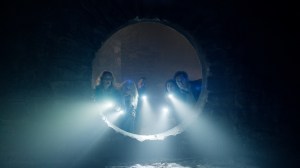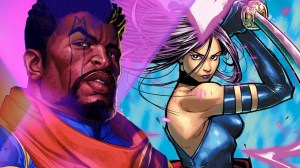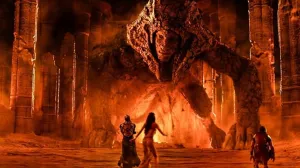This week DC Comics is releasing a great new collection titled The DC Universe by Neil Gaiman. Much like the similarly titled collection of work by Alan Moore, this volume pulls together all of the single issues and short stories from a beloved comics writer during their tenure with DC Comics. The likes of Sandman, Death, Black Orchid, and Books of Magic are nowhere to be seen as they’re sprawling epics or mini-series contained in their own collections. The issues found within this new trade paperback have largely remained out of print, only now becoming accessible to readers without extensive diving through back issues.
Videos by ComicBook.com
It’s an exciting combination of work from one of the most celebrated writers in comics and prose today. To celebrate these stories finally being formatted for bookshelves, we’ve looked back through Gaiman’s short stories within the DC universe and ranked them against one another. This ranking includes all six of the stories contained in The DC Universe by Neil Gaiman as well as one other found in the Batman: Black and White anthologies. Together they’re the easiest, quickest reads from a writer who normally plays a much longer game — like the 75 issues and multiple mini-series surrounding Sandman. So take a look ahead to see which stories you might want to visit or revisit first when this new collection joins your library.
7. Green Lantern/Superman: Legend of the Green Flame

Art by Eddie Campbell, Mark Buckingham, et al.
Issues: Green Lantern/Superman: Legend of the Green Flame #1
When we discuss Neil Gaiman’s comics, we typically think of the imaginative alterations of reality or radical shifts in perspective. He’s an inventive writer who regularly pushes his stories well beyond expectations of the mainstream. That’s what make this prestige one-shot a bit of a disappointment. It’s a team-up that plays safely within the realm of what superhero readers would expect from Superman and Green Lantern joining forces. At its best the story emphasizes the value of this friendship given Hal Jordan’s rough state in the early ’90s. The pair are also briefly deceased, but when compared to the rest of Gaiman’s work, there’s nothing particularly exciting to be found in this volume.
6. When Is A Door?

Art by Bernie Mireault
Issues: Secret Origins Special #1
The second Gaiman-penned installment in this special issue, it utilizes the same film crew found in “Original Sins” to interview The Riddler who is camped out amongst aging, villainous Silver Age paraphernalia. The Riddler’s riddles don’t make much sense, but that serves a purpose as he is contrasted with the more violent Batman villains of the modern era. This little bit of commentary on changing standards in comics provides an interesting core to the story, but the story itself doesn’t contain much of a narrative arc. Instead, it’s a metaphor for how Batman comics have changed with little to say beyond that.
5. Whatever Happened To The Caped Crusader?

Art by Andy Kubert
Issues: Batman #686 and Detective Comics #853
This “ending” for Batman purposefully played on the classic Alan Moore and Curt Swan comics “Whatever Happened to the Man of Tomorrow?” about the death of Superman. It’s a comparison that does not hold up well and makes it more difficult to enjoy this story just for what it is. Kubert’s work plays with the many eras and conceptions of Batman during a funeral thrown by his villains. The story attempts to reach some points about the seemingly infinite nature of Batman, but never really land. Instead much of what this story strives to do is accomplished better in the “Batman R.I.P.” comics that ran at the same time. It’s a fine eulogy, but a lesser work of Gaiman’s.
4. Original Sins

Art by Mike Hoffman
Issues: Secret Origins Special #1
The other Gaiman story from this issue emphasizes the experience of a film crew seeking stories about Batman’s super villains for a documentary. They are disappointed by many of the responses and readers might be as well, but for good reason. The individuals who survive these horrific crimes rarely want to speak about them. An occasional henchman or devastated wife will get on camera, but this juxtaposition just makes the desire for fame among the documentarians more distasteful. There’s a very clever exploration of entertainment in grief here with an even more clever twist ending.
3. A Black And White World

Art by Simon Bisley
Issues: Batman: Black and White #2
This is the one story you won’t find in The DC Universe by Neil Gaiman, as it’s already part of the “Black and White” collections. Gaiman tells a story of Batman and The Joker with one big twist: they’re both actors performing as the characters. Using this lens, Gaiman erases much of the violence or easy moralizing elements from the relationship in order to focus on how these two consistently interact. There’s a notion that the pair needs one another and that they function as much as co-workers as they do adversaries. It puts in an interesting spin on the Batman mythos that has been explored further by later writers like Scott Snyder.
2. Pavane

Art by Mark Buckingham
Issues: Secret Origins #36
“Pavane” is an example of Gaiman’s best character work as he offers a new perspective on the life of Poison Ivy. He frames the story from an employee of the Suicide Squad who seeks to evaluate Ivy as a potential member, while lying about his own attraction to her. The man is revealed to be an ugly individual, using women and cheating on his wife while lying to everyone about his motives. His actions and motives create sympathy for Ivy as she shares her story and the rage that suddenly makes much more sense. It is a great feminist reading of Poison Ivy that plays on her earliest appearances in comics and has grown into a key part of the character’s future stories.
1. Metamorpho

Art by Mike Allred
Issues: Wednesday Comics #1 – 12
Everything about this story evokes invention and creativity. Gaiman’s wild camp writing, Allred’s strange designs and layouts, and even the newsprint format of Wednesday Comics itself all defied expectations. If someone is looking for a short introduction into why Gaiman is revered in comics, these 12 strips make for a perfect thesis statement. They are all about pushing boundaries and following new ideas wherever they might lead. It manages to be fun while also engaging with genuine pathos. “Metamorpho” is Gaiman at his absolute best and certainly the crown jewel of The DC Universe by Neil Gaiman.








